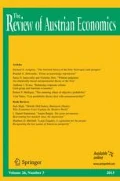Abstract
Challenging the dominant view, we claim that Hayek’s monetary views did not significantly change over his lifetime. The prevalent perception of early Hayek as a money stream stabilizer and late Hayek as a price level stabilizer is attributable to an unjustified normative interpretation of Hayek’s positive analysis. We argue that in his contributions to monetary theory, Hayek took the goals of monetary policy as exogenously given and analysed the efficiency of different means of achieving them. Hayek’s allegedly inconsistent transformation from a critic to an advocate of price level stabilization is explained by a change of issues under his focus, rather than by a change in his positive views. We also claim that Hayek was always aware that every practical monetary policy involves difficult trade-offs and that he was therefore reluctant to impose his own value judgments on what people should strive for.
Similar content being viewed by others
Notes
Money stream is Hayek’s term for nominal spending (MV).
See also Cochran (2011).
“As he was logically compelled to do if he were to embrace consumer price-level stabilization, Hayek here essentially repudiated his earlier business cycle theory…” (White 1999:118).
To be more precise, Hayek (1933:147, 168) was explicit that business cycle might be initiated by non-monetary forces (e.g. technological shock); Yet, in his view, these non-monetary forces lead to business cycle only if monetary distortions are present. For more on the categorization of Hayek’s theory as monetary, see O’Driscoll and Rasmussen (2012).
The other conditions are the perfect flexibility of prices and correct prediction of the future movement of prices (Hayek [1933] 1984:161).
This claim of Hayek’s has been criticized by Block and Garschina (1996). However, they are incorrect in attributing to Hayek the normative statement that we “must continue to use fractional reserve banking in order to spread the development of technical and commercial knowledge” (Block and Garschina 1996:85). See e.g. Hayek (1934: 161–162).
Yet, at the same time, Hayek II ([1976] 1990:87) believed that divergences between investment and saving under a stable price level “would probably be of an order of magnitude about which we need not worry” when compared to those “which necessarily accompany the major swings in the price level.”
Haberler (1986) understands Hayek II’s acute attempt to cut inflation as a response to periods of high inflation and the loss of trust in politically controlled central banks. This is confirmed by Hayek himself: “The pressure for more and cheaper money is an ever-present political force which monetary authorities have never been able to resist [,..] Our only hope for a stable money is indeed now to find a way to protect money from politics” (Hayek 1976:15–16).
This marks another difference of focus between Hayek I and Hayek II: While Hayek I looked for policy means within a given institutional setting, Hayek II included a change in monetary institutions as a policy means.
References
Block, W., & Garschina, K. M. (1996). Hayek, business cycles and fractional reserve banking: continuing the de-homogenization process. The Review of Austrian Economics, 9(1), 77–94.
Caldwell, B. J. (1988). Hayek’s transformation. History of Political Economy, 20(4), 513–541.
Carilli, A., & Dempster, G. (2008). Is the Austrian business cycle theory still relevant? The Review of Austrian Economics, 21(4), 271–281.
Carilli, A., Dempster, G., & Rohan, J. (2004). Monetary reform from a comparative-theoretical perspective. Quarterly Journal of Austrian Economics, 7(3), 29–44.
Cochran, J. P. (2011). Hayek and the 21st century boom-bust and recession-recovery. Quarterly Journal of Austrian Economics, 14(3), 263–287.
Foss, N. J. (1995). More on Hayek’s transformation. History of Political Economy, 27(2), 345–364.
Gustavson, M. (2010). The Hayek rule: a new monetary policy framework for the 21st century. Reason Foundation Policy Study, 389.
Haberler, G. (1986). Reflections on Hayek’s business cycle theory. Cato Journal, 6(2), 421–435.
Hayek, F. A. (1933). Monetary theory and the trade cycle. New York: Harcourt, Brace & Co.
Hayek, F. A. (1934). Capital and industrial fluctuations. Econometrica, 2(2), 152–167.
Hayek, F. A. (1967). Prices and production (2nd ed.). New York: Augustus M. Kelley.
Hayek, F. A. (1976). Choice in currency: a way to stop inflation. London: Institute of Economic Affairs.
Hayek, F. A. (1984). On neutral money. In: Money, capital and fluctuations: Early essays (pp 159–162) London: Routledge.
Hayek, F. A. (1990). Denationalisation of money: The argument refined. London: The Institute of Economic Affairs.
Hayek, F. A. (1999). The future unit of value. In S. Kresge (Ed.), Good money, Part 2 (pp. 238–252). Liberty Fund: Indianapolis.
Hayek, F. A. (2008). A free-market monetary system. Auburn: Ludwig von Mises Institute.
Hutchison, T. W. (1981). The politics and philosophy of economics: Marxians, Keynesians, and Austrians. Oxford: Blackwell.
O’Driscoll, G., & Rasmussen, D. (2012). Did Hayek have a monetary theory of business cycles? The Review of Austrian Economics, 25(3), 255–262.
Steele, G. (2005). Hayek’s theory of money and cycles: retrospective and reappraisal. Quarterly Journal of Austrian Economics, 8(1), 3–14.
White, L. H. (1999). Hayek’s monetary theory and policy: a critical reconstruction. Journal of Money, Credit and Banking, 31(1), 109–120.
White, L. H. (2008). Did Hayek and Robbins deepen the great depression? Journal of Money, Credit and Banking, 40(4), 751–768.
Witt, U. (1997). The Hayekian puzzle: spontaneous order and the business cycle. Scottish Journal of Political Economy, 44(1), 44–58.
Acknowledgments
We would like to thank Petr Bartoň, Pavel Potužák and two anonymous referees for their helpful comments on earlier drafts. Any mistakes are, of course, ours.
Author information
Authors and Affiliations
Corresponding author
Rights and permissions
About this article
Cite this article
Komrska, M., Hudík, M. Hayek’s monetary theory and policy: A note on alleged inconsistency. Rev Austrian Econ 29, 85–92 (2016). https://doi.org/10.1007/s11138-015-0300-5
Published:
Issue Date:
DOI: https://doi.org/10.1007/s11138-015-0300-5
Keywords
- F. A. Hayek
- Positive economics
- Normative economics
- Monetary policy
- Austrian business cycle theory
- Price level stabilization
- Money stream stabilization



